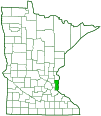gnat ogre
(Holcocephala abdominalis)
Conservation • Description • Habitat • Ecology • Distribution • Taxonomy
Conservation Status |
|
|||||||
| IUCN Red List | not listed |
|||||||
| NatureServe | not listed |
|||||||
| Minnesota | not listed |
|||||||
Description |
||
Holcocephala abdominalis is a small gnat ogre. It occurs in North America from Quebec to Florida west to Minnesota and eastern Texas. Adults are found from early July to early September in damp, grassy, open areas near woodlands. Adults are light brownish-yellow and 3⁄16″ to ¼″ (4.5 to 7.0 mm) in length. The head is brownish yellow in front, ash gray behind. It is much broader than the thorax, and it is strongly compressed from back to front. There are two large compound eyes on the side of the head and three small simple eyes (ocelli) in a triangle on top of the head. The top of the head is depressed (“hollowed out”) between the compound eyes. The compound eyes are relatively large and very widely spread apart. This feature distinguishes the genus Holcocephala from all other fly genera in the United States. Each compound eye is composed of numerous visual elements (ommatidia) with a hexagonal outer face (facet). The facets on the front of the eye are very large but gradually decrease in size approaching the upper, outer, and lower margins. The facets are black but have bright bronze reflections. The antennae are short, slender, and black. They have three segments. The first two segments are very short and rounded. The first segment is spindle-shaped, distinctly broader in the middle. The third segment is two times as long as the first two segments together. At the tip of the third segment there is a long extension (style). The style is well developed, nearly as wide as the third segment at the base and tapering to a sharp point at the tip. The thorax is stout, brownish-yellow, and strongly arched. It is densely covered with short, velvety hairs that completely hide the underlying color. It has no bristles. There are three segments. Each segment has four principal exoskeletal plates, one above, one below, and one on each side. The upper (dorsal) plates, from front to rear, are the prescutum, scutum, and scutellum. The prescutum and scutum have scattered, longer, rearward-curved, bristle-like hairs, but no long stiff bristles. There is a broad, brown, longitudinal stripe in the middle and another stripe on each side. The lateral stripes are interrupted at the groove (suture) between the prescutum and scutum, broader and dark on the prescutum, more diffuse and sometimes much lighter on the scutum. The scutellum is unmarked. The abdomen is broad at the base and tapered toward the tip. It is reddish-yellow with brown markings above, pale tan below. It has no bristles. The wings are longer than the abdomen. They are blackish, mostly dark, pale on the outer third. They are held over the body when at rest. Every cell near the wing tip is broadly open. The legs are chestnut brown and are sparsely covered with fine hairs and numerous, weak bristles. The third segment (femur) is sometimes black above, and the bristles are confined to the underside. The fourth segment (tibia) is more or less black at the tip. On the front leg there is no claw-like spur at the tip. On the hind leg it is swollen at the tip, about 35% wider than the femur. The last part of the leg (tarsus), corresponding to the foot, has five segments. The tip of each segment is more or less black. The first segment is at least twice as long as the second segment. The last segment has a pair of black claws at the tip. On the hind leg of the male, the tibia and the first tarsal segment are much broader, about 35% broader, than the femur. |
||
Size |
||
Total length: 3⁄16″ to ¼″ (4.5 to 7.0 mm) |
||
Similar Species |
||
Habitat |
||
Damp, grassy, open areas near woodlands. |
||
Ecology |
||
Season |
||
Early July to early September |
||
Behavior |
||
Adults perch at the tip or on the stalk of a grass blade when hunting. |
||
Life Cycle |
||
|
||
Larva Food |
||
|
||
Adult Food |
||
Gnats and other small flying insects |
||
Distribution |
||||
|
Sources |
|||
| 11/21/2022 | ||||
Occurrence |
||||
|
||||
Taxonomy |
|||
Order |
|||
Suborder |
Brachycera |
||
Infraorder |
Cyclorrhapha |
||
Superfamily |
Asiloidea |
||
Family |
|||
Subfamily |
Trigonomiminae |
||
Tribe |
Trigonomimini |
||
Genus |
|||
Most sources place the genus Holcocephala in the tribe Damalini. However, a handful of sources reject that name as a junior synonym of Xenomyzini, following Article 40.1 of the ICZN rules. The name Trigonomimini is older and therefore has precedence. The short list of sources that place Holcocephala in the tribe Trigonomimini includes Robber Flies of the World, AsilidaeData, The National Museum of Natural History at the Smithsonian Institution, and iNaturalist. |
|||
Synonyms |
|||
Dasyopogon abdominalis Dasypogon aeta Dasypogon laticeps Discocephala rufiventris |
|||
Common Names |
|||
This species has no common name. The common name for the genus Holcocephala is gnat ogres, and it is applied here for convenience. |
|||
Glossary
Femur
On insects and arachnids, the third, largest, most robust segment of the leg, coming immediately before the tibia. On humans, the thigh bone.
Ocellus
Simple eye; an eye with a single lens. Plural: ocelli.
Scutellum
The exoskeletal plate covering the rearward (posterior) part of the middle segment of the thorax in some insects. In Coleoptera, Hemiptera, and Homoptera, the dorsal, often triangular plate behind the pronotum and between the bases of the front wings. In Diptera, the exoskeletal plate between the abdomen and the thorax.
Scutum
The forward (anterior) portion of the middle segment of the thorax (mesonotum) in insects and some arachnids.
Tarsus
On insects, the last two to five subdivisions of the leg, attached to the tibia; the foot. On spiders, the last segment of the leg. Plural: tarsi.
Tibia
The fourth segment of an insect leg, after the femur and before the tarsus (foot). The fifth segment of a spider leg or palp. Plural: tibiae.
Visitor Photos |
|||||
Share your photo of this insect. |
|||||
| This button not working for you? Simply email us at info@MinnesotaSeasons.com. Attach one or more photos and, if you like, a caption. |
|||||
Alfredo Colon |
|||||
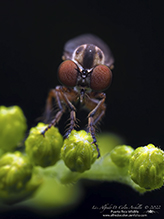 |
|||||
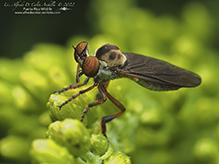 |
 |
||||
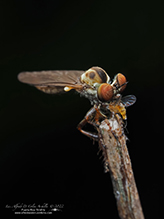 |
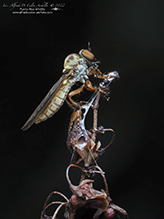 |
||||
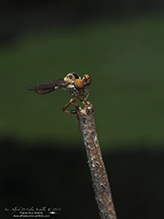 |
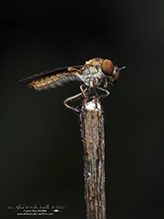 |
||||
 |
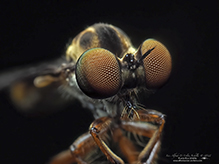 |
||||
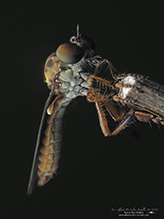 |
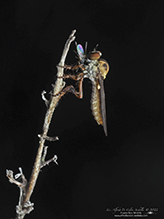 |
||||
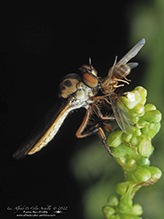 |
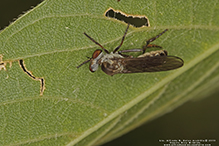 |
||||
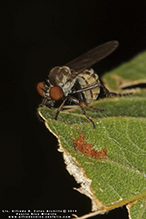 |
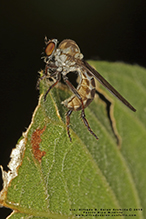 |
||||
MinnesotaSeasons.com Photos |
|||||
|
|||||

Slideshows |
||

Visitor Videos |
|||
Share your video of this insect. |
|||
| This button not working for you? Simply email us at info@MinnesotaSeasons.com. Attach a video, a YouTube link, or a cloud storage link. |
|||
Other Videos |
|||
| Robber fly eating insects & grooming | Holcocephala GoTrails |
|||
About
Aug 27, 2020 Robber fly eating insects & grooming | flying, feeding, hunting / catching prey, attack | Holcocephala fusca / abdominalis, gnat ogre | assassin, Asilidae | cleaning itself | close up | Facts, Information, Documentary, Identification, Habitat, Behavior, Habits | Diet: wasp, bee, spider, dragonfly | bite | eyes, mouthparts, mystax, stout proboscis, sharp sucking hypopharynx | HD video | Animal, Wildlife, Nature | #gotrails, #robberfly, #arthropod, #insect, #insects |
|||
| Robber Fly (Holcocephala) with prey Henry Jurenka |
|||
About
May 8, 2020 This mosquito-sized robber fly catches a tiny fly |
|||


Created: 1/29/2021
Last Updated:
